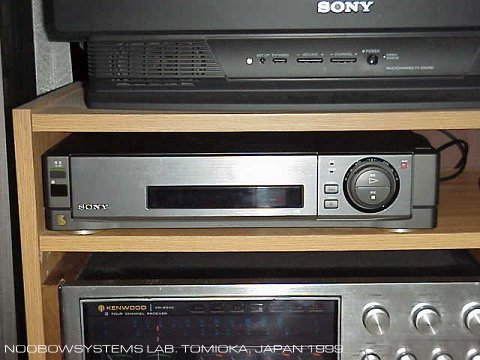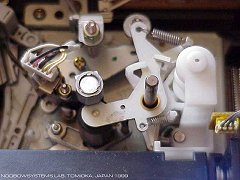


|
SONY SLV-FX5 VHS Hi-Fi Video Cassette Recorder (1993) Revived : Dec. 1999 Retired : Jan. 2008 |
|
When I returned from my business trip to Europe,
Yome, who is a cofounder of NoobowSystems Lab.,
complained that our Toshiba VCR which we had been using for nearly 8 years was no longer working.
Quick check revealed that it wasn't easy to fix.
No mechanism responded, although the logic processor seemed to be working.
Not only the deck mechanism but the tuner section did not work either.
Yome had missed several her favorite programs while I was away from the lab. I unpacked another JVC VCR which I had purchased years ago at Fry's, Sunnyvale California. It is the U.S. version model Both U.S. and Japan uses NTSC format so there should not be a problem, power difference may not be a matter either. Reconfigured from CABLE to TV, activated automatic tuner setup from the JVC's remote control. Hurray! It received all local channels clearly. I found that the channel 2 in the U.S. is same as Japanese channel 1. Therefore the channel 52, our local NHK-TV station, appears on the channel 53 on the deck's front panel. Satisfaction did not last long, however. There seems to be a difference with sub-audio channel encoding/decoding format. Some Japanese TV programs such as movies or NHK news offer "bilingual" audio; one may choose English audio instead of Japanese. (No, it's not a built-in automatic on-the-fly electronic translator... we still need to wait for years for it. ) With the U.S. version JVC VCR, no bilingual audio (second audio) was available. |
|
Giving one shot of "Kure 5-56" (equivalent to WD-40 in the U.S.) did not solve anything.
I decided to disassemble the arm as well as its corresponding parts.
No special tool was necessary for the job.
I wiped the pivot shaft with alcohol, applied 5-56 to the hole of the arm, and reassembled.
Good, the arm now moves smoothly.
Well, I might be better using silicon oil or something instead of 5-56.
Let's do so when 5-56 fails to maintain the smoothness. It also required to realign the plastic gear meshing phase, for they misaligned when a drive gear attempted to rotate another gear which should drive the arm. Though without a service manual, I managed to find the proper meshing phase after several try and errors. The loading-unloading mechanism began to work just as it should. Picture quality of the deck is not so clisp, possibly due to the wore head. But it has certainly come back to life again. Now we get everything and I've got Toshiba VCR listed in my back-to-life-again project list! |

Capstan and Pinchroller Mechanism
Click here for the movie (small, 128KB) showing how it works, if you dare to watch... |
|
Full 5 years have passed since the deck became operational order.
The SLV-FX5 works flawlessly in the living room of our lab.
The last year was quite tough to the deck, because
our new chief science officer
put the deck to the severe endurance test;
she loves to turn the power on and off repeatedly and enjoy listenging its mechanical sound.
When she turned 2 years old, she learned how to eject and insert the cassette ----
the tape loading mechanism got full 1 month worth of work in a day. Honestly if she would give a final shot to the deck, we'd be happy to purchase a new HDD/DVD recorder. But SLV-FX5 is her good friend; she really enjoys watching her favorite video program on it. |
|
In December 2007,
8 years after its revival,
the deck failed to play tapes anymore.
Sandstorm band noise didn't disappear although the desk's Digital Auto Tracking worked hard to correct it.
Seemed like the video head did not give enough output to the head amplifier.
Opening the case, tried to clean up the head as well as other guides with alcohol,
did not solve it.
Apparently it required professional servicing,
most likely replacing its vital video head.
However, nearly 14 years has passed since it was manufactured and service parts would not be available.
Degausing the head would give it back the life, but no such arrapatus in the lab.
Identical unit may be purchased for 3 dollars in recycle shops in search for a usable head,
but it won't be worth in any way, when a new VHS deck can be purchased with rock bottom price. .... So it is time to say farewell to our old friend. Perhaps the unit will be stowed for another years, for a parts salvaging purpose. At least a part of it may be someday given a new way of life. |